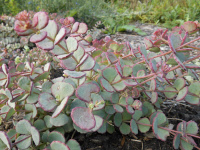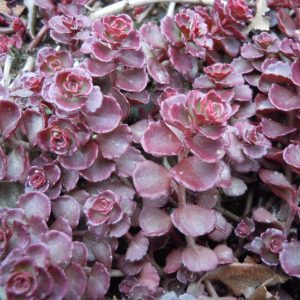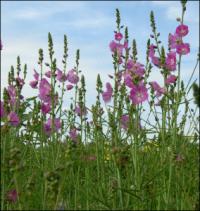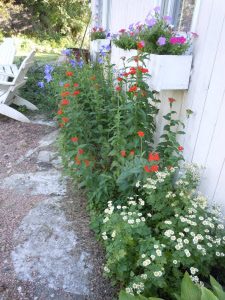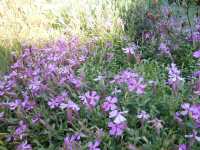Drought, Xeric & Dry Soil Plants
Showing 113–120 of 132 results
-
Sedum sieboldii syn Hylotelephium sieboldii, October Daphne Z 3-9
Fleshy gray-green foliage edged with pink encircles the prostrate stems, flowering strawberry pink in fall. Perfect for rock gardens, front of border, fairy gardens, roof gardens, troughs and groundcover or anyplace with drought.
Fleshy gray-green foliage edged with pink encircles the prostrate stems, flowering strawberry pink in fall. Perfect for rock gardens, front of border, fairy gardens, roof gardens, troughs and groundcover or anyplace with drought.
Size: 4" x 8"
Care: full sun in moderately fertile, well-drained soil.
Native: Japan
Wildlife Value: Drought tolerant and deer resistant.
Awards: Elisabeth Carey Miller Botanical Garden Great Plant PickSedum means “plant that sits.” “Live forever” is an ancient Greek name for sedums. The Roman Pliny claimed that sedum’s juice treated wounds. In the 1500’s English herbalist Gerard called sedums “very full of life,” referring to succulent’s quality of being very easy to grow. This species named for its discoverer, Dr. Philipp Franz von Siebold (1791-1866). Von Siebold, a German doctor, worked for the Dutch East India Company as its resident physician on Deshima Island, off the coast of Japan. He boldly became too knowledgeable about Japanese affairs and was imprisoned by the Japanese in 1826 and then banished in 1828. When he left he carried nearly 500 plants with him to Europe. William Robinson, father of the mixed perennial border, described Sedum sieboldii as beautiful. He advised gardeners to grow it “in strong loam and mortar rubble in fully exposed positions (and use it as) an excellent plant for vases in summer.”
-
Sedum spurium ‘Coccineum’ Dragon’s blood Z 4-9
Mat-forming evergreen. In spring red encircle its fleshy, green, round leaves. In summer leaves turn bronze and in fall deep burgundy. Small, bright pink, star-shaped flowers.
Mat-forming evergreen. In spring red encircle its fleshy, green, round leaves. In summer leaves turn bronze and in fall deep burgundy. Small, bright pink, star-shaped flowers.
Size: 4-6" x spreading 12-18"
Care: sun in well-drained to moist well-drained soil
Native: Caucasus Mountains
Awards: Royal Horticultural Society Award of Garden Merit; Great Plant PickFranklin Gardens in Big Springs Arkansas sold this in 1948 for 50 cents calling it “a new sedum. . . “Called “a new Sedum that will surely become popular” New and Noteworthy Hardy Plants Spring Flor-Acres’ Perennials 1950 p. 13
-
Sesleria autumnalis Autumn Moor Grass Z 5-9
Fresh-green spring narrow blades of grass in summer add airy purplish flower spikes with silver-white stamens on this low mounding, arching grass. Blades have a striking yellow-green color that sometimes develops a soothing golden autumn tint. Spike-like silvery flowers rise above the leaves and mature into soft tan seed heads by autumn.
Fresh-green spring narrow blades of grass in summer add airy purplish flower spikes with silver-white stamens on this low mounding, arching grass. Blades have a striking yellow-green color that sometimes develops a soothing golden autumn tint. Spike-like silvery flowers rise above the leaves and mature into soft tan seed heads by autumn.
Size: 9-24” x 12-18”
Care: sun to part shade in moist well-drained to well-drained soil, drought tolerant
Native: SE Europe east to Caucusus
Wildlife Value: walnut, salt and deer tolerant
Awards: Royal Horticultural Society Award of Garden Merit. Gardens Illustrated “100 Must-Have Garden Plants,” 2013.Collected in Slovenian mountains near Idria, c. 1760 by and 1st described in Flora Carniolica by Giovanni Antonio Scopoli (1723-1788) physician, naturalist and author. Sesleria is named to honor Leonardo Selser, 18th century Italian botanist and physician, contemporary and likely friend of Scopoli
-
Sidalcea malvaeflora Checker bloom Z 5-9
Bright pink mallow type blooms looking like a miniature hollyhock.
Bright pink mallow type blooms looking like miniature hollyhock.
Size: 2-3' x 10"
Care: sun to part shade in well-drained soil
Native: western No. America
Wildlife Value: Attracts large white skipper butterflies.Sidalcea is the conjunction of sida and alcea. Collected by Mexican botanist José Moziño around 1790 while on the Expedición Real de Botánica, probably in today’s Southern California.
-
Silene chalcedonica syn. Lychnis chalcedonica Maltese cross, Jerusalem cross Z 4-8
Early and midsummer, blood-colored heads made of clusters of flowers each with petals like spokes of a wheel with edges curved down. Blooms in summer.
Early and midsummer, blood-colored heads made of clusters of flowers each with petals like spokes of a wheel with edges curved down. Blooms in summer.
Size: 3-4' x 12"
Care: Sun to part shade, moderately fertile, well-drained soil. Will repeat bloom if deadheaded.
Native: Western Russia
Awards: England’s Royal Horticultural Society Award of Merit.Lychnis named by Theophrastus in the 3rd century B.C. for “lamp” (lychnos) due to using the leaves of Lychnis coronaria for lamp wicks, but some say due to the flame-colored flowers. Chalcedonica refers to Chalcedon, a district near Constantinople. Louis IX reputedly transported this plant from Jerusalem to France on his return from the Crusades. By 1597 it was “very common everywhere” in England. In 1912 Liberty Hyde Bailey called this “one of the best of old-fashioned flowers.” Grown by both Washington and Jefferson.
-
Silene coronaria syn. Lychnis coronaria Rose campion Z 4-8
Bright crimson/magenta 5-round-petaled flowers contrast felted silvery-white foliage in early to midsummer. Be sure to let it drop its seeds for more plants next year or the year after.
Bright crimson/magenta 5-round-petaled flowers contrast felted silvery-white foliage in early to midsummer. Be sure to let it drop its seeds for more plants next year or the year after.
Size: 24" x 18"
Care: Full sun in moist well-drained to well-drained soil
Native: Southeastern Europe
Awards: England's Royal Horticultural Society Award of Merit.Lychnis named by Theophrastus in the 3rd century B.C. for “lamp” believed to be because the downy leaves were used to make lamp wicks, but some say due to the flame-colored flowers. Mythology reports that the Rose campion sprang from the bath of Aphrodite. Rose campion has been in European garden cultivation since the 1300’s. Parkinson in 1629 wrote of the Rose campion: “The single red Rose campion hath divers thick, hoary or woolly long greene leaves, abiding greene all the winter, and in the end of the spring or beginning of summer, shooteth forth two or three hard round woolly stalkes, with some joints thereon, and as every joint two such like hoary greene leaves as those below, but smaller, diversly branched at the toppe, having one flower upon each severall long stalke … of a perfect red crimson colour …” Paradisi in Sole Paradisus Terrestris. Both George Washington and Thomas Jefferson grew this plant. (Jefferson in 1807.)
-
Silene schafta Schaft’s catchfly, Moss Z 5-7
One of the spectacular late season blooms –clusters of five-petaled, jagged-edge, bright magenta flowers on short mounds, September to October. Perfect for front of borders or rock gardens.
OUT OF STOCK
One of the spectacular late season blooms –clusters of five-petaled, jagged-edge, bright magenta flowers on short mounds, September to October. Perfect for front of borders or rock gardens.
Size: 6” x Slowly spreading
Care: full sun in well-drained to moist well-drained soil
Native: Russia
Awards: England’s Royal Horticultural Society Award of MeritIntroduced from its native Russia in 1844. First described by and probably collected by Johann Gmelin (1709-1755) German naturalist who spent years hunting plants in Russia and authored four-volume Flora Sibirica. In Greek mythology Silene was a companion of Bacchus who was covered with foam. William Robinson, father of the mixed perennial border, described the flowers of this species as being “very neat tufts.”
-
Solidago caesia syn. Solidago axillaris Blue-stemmed goldenrod, Wreath goldenrod Z 4-9
Graceful, arching wands of clustered gold, with contrasting blue-green stems in September-October. One of the last perennials to bloom. Clump forming, noninvasive perennial.
Graceful, arching wands of clustered gold, with contrasting blue-green stems, in September-October. Clump forming, noninvasive perennial.
Size: 18-24” x 16-20”
Care: part shade to shade in well-drained soil, drought tolerant
Native: Nova Scotia to WI, south to FL and west to TX, Wisconsin native
Wildlife Value: With both nectar and pollen this attracts, bees, wasps and flies. It is host to caterpillars of some moths.The Latin name is a combination of solidus and ago, meaning “I make whole”, referring to its historic medicinal uses. According to William Cullina it has antioxidant, diuretic, astringent and antifungal properties and was used to treat urinary tract and yeast infections, sore throats and diarrhea. (W. Cullina, NEWFS, p. 197) Named by Swedish botanist Linnaeus in 1753.

